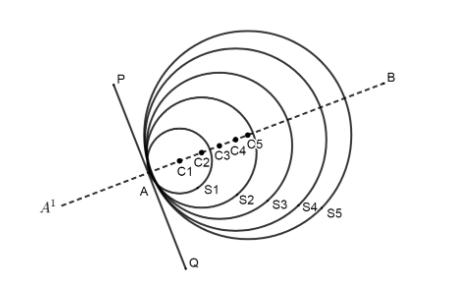
Write true or false and justify your answer in each of the following:
If a number of circles touch a given line segment PQ at a point A, then their centers lie on the perpendicular bisector of PQ.
(A) True
(B) False
(C) Ambiguous
(D) Data insufficient
Answer
578.4k+ views
Hint: To solve this question, we will draw a line and we will draw a number of circles touching that line. After doing this, we will find the focus of the centers of all these circles and then we will answer according to the options given in question
Complete step-by-step answer:
Now, in the question, it is given that a number of circles touch the given line segment at a point. So, we will draw the figure as the information given in question:

Here, in the above figure, we have drawn five circles \[{{\text{S}}_{1}},\text{ }{{\text{S}}_{2}},\text{ }{{\text{S}}_{3}},\text{ }{{\text{S}}_{4}}\text{ and }{{\text{S}}_{5}}\] which has centers \[{{\text{C}}_{1}},\text{ }{{\text{C}}_{2}},\text{ }{{\text{C}}_{3}},\text{ }{{\text{C}}_{4}}\text{ and }{{\text{C}}_{5}}\] the point at which all these circles touch the line segment PQ is A. we can also see from the figure that the centers of circles lie on a straight line. Now, we have to determine the nature of this line. We know that if a line touches a circle at only one point then that line will be the tangent of the circle at that point. In our question, it is given that all the circles touch the line segment PQ at A. Thus the line PQ will be the tangent to all these circles. Now, the line AB passes through the centers of all these circles. It also passes through the point A. Thus the line AB will be normal to all these circles. Thus, we can say that the line \[{{\text{A}}^{1}}\text{B}\]will be perpendicular to line PQ. But here, we do not know anything about the point A i.e. at which position does it lie in the line segment.
Hence, option (D) is correct, because we are not given any information about the point A. If A is the midpoint of the line segment PQ then \[{{\text{A}}^{1}}\text{ B}\] will be a perpendicular bisector otherwise it will be not. So the answer depends on the point on the position of A.
Note: Here, while solving the question, we have considered that the circles lie in the second plane (x-y plane). Even if there is a circle in a third plane (x-y-z plane) and it is touching a given line segment at point A, its center will be on the perpendicular bisector of PQ. Another thing to note is that the radius of the circle has no role in it. Any circle of real radius will satisfy the condition.
Complete step-by-step answer:
Now, in the question, it is given that a number of circles touch the given line segment at a point. So, we will draw the figure as the information given in question:

Here, in the above figure, we have drawn five circles \[{{\text{S}}_{1}},\text{ }{{\text{S}}_{2}},\text{ }{{\text{S}}_{3}},\text{ }{{\text{S}}_{4}}\text{ and }{{\text{S}}_{5}}\] which has centers \[{{\text{C}}_{1}},\text{ }{{\text{C}}_{2}},\text{ }{{\text{C}}_{3}},\text{ }{{\text{C}}_{4}}\text{ and }{{\text{C}}_{5}}\] the point at which all these circles touch the line segment PQ is A. we can also see from the figure that the centers of circles lie on a straight line. Now, we have to determine the nature of this line. We know that if a line touches a circle at only one point then that line will be the tangent of the circle at that point. In our question, it is given that all the circles touch the line segment PQ at A. Thus the line PQ will be the tangent to all these circles. Now, the line AB passes through the centers of all these circles. It also passes through the point A. Thus the line AB will be normal to all these circles. Thus, we can say that the line \[{{\text{A}}^{1}}\text{B}\]will be perpendicular to line PQ. But here, we do not know anything about the point A i.e. at which position does it lie in the line segment.
Hence, option (D) is correct, because we are not given any information about the point A. If A is the midpoint of the line segment PQ then \[{{\text{A}}^{1}}\text{ B}\] will be a perpendicular bisector otherwise it will be not. So the answer depends on the point on the position of A.
Note: Here, while solving the question, we have considered that the circles lie in the second plane (x-y plane). Even if there is a circle in a third plane (x-y-z plane) and it is touching a given line segment at point A, its center will be on the perpendicular bisector of PQ. Another thing to note is that the radius of the circle has no role in it. Any circle of real radius will satisfy the condition.
Recently Updated Pages
Master Class 12 Economics: Engaging Questions & Answers for Success

Master Class 12 Maths: Engaging Questions & Answers for Success

Master Class 12 Biology: Engaging Questions & Answers for Success

Master Class 12 Physics: Engaging Questions & Answers for Success

Basicity of sulphurous acid and sulphuric acid are

Master Class 12 Business Studies: Engaging Questions & Answers for Success

Trending doubts
What are the major means of transport Explain each class 12 social science CBSE

Which are the Top 10 Largest Countries of the World?

Draw a labelled sketch of the human eye class 12 physics CBSE

How much time does it take to bleed after eating p class 12 biology CBSE

Explain sex determination in humans with line diag class 12 biology CBSE

Differentiate between homogeneous and heterogeneous class 12 chemistry CBSE




